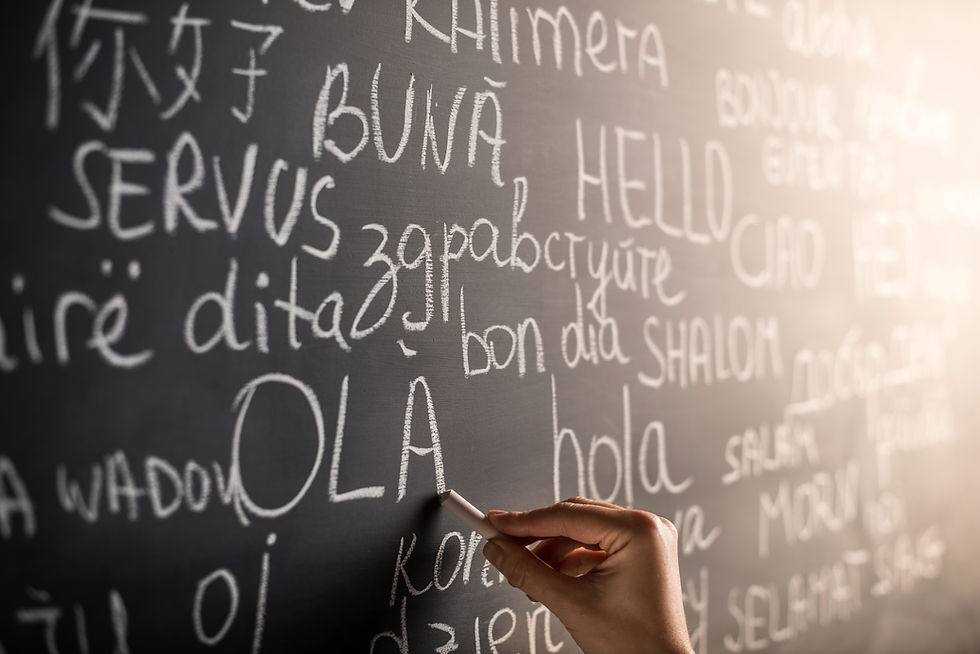Movement is just another language - Take the Time to Learn It
- Kevin Mullins

- Apr 13, 2018
- 5 min read
Think back to the days of your youth. Picture the classrooms with dinosaurs on the walls, motivational posters everywhere you look and a worksheet on your desk. Your teacher, ever so patient, helped you sound out the syllables and spell the words that you needed to learn.
Somewhere between picking your nose and lunch it started to click - these little letters make words and words make sentences. Eventually sentences made coherent thoughts, at least for some of us, and we were on our way to communicating effectively.
Do you remember those days clearly?
Can you remember sounding out syllables at your dinner table at getting frustrated that you weren't getting it?
Probably not, but you speak your native language daily and are able to communicate with the world around you and so it's safe to say the teaching worked. Somehow all those worksheets with blank lines and pictures led you to being able to fill blank lines of notebook paper, or the empty white space of a word document, with text as you rushed to finish another paper in school.
It's all pretty mindless now, isn't it? You can rattle of twenty text messages and a Facebook post in a matter of minutes if the right blend of current events and raging emotion combine...all because of the days in grade school.
What if we thought about exercise the same way?
What if, instead of going to the gym and expecting to be amazing at everything, we embraced the learning process that is learning a new language?
See, exercise is no different than English, Spanish, French, or Swahili. It is a language not of the tongues but of the body. Colleges often refer to this language as Kinesiology, since the word literally translates to "the study of human movement", but we don't need to be that formal.
Let's just call it the language of movement.
Traditional languages relies on little elements working together (letters) to create bigger elements (words), which when arranged appropriately begin a line of communication (sentences) that can be organized in a series (a paragraph) that effectively builds the finished product (the complete message). The final step is not possible, at least it shouldn't be, without adequate mastery of the previous steps.

This formula is no different with exercise. Here's how it works. Every exercise (words) is made up of a bunch of little elements working together appropriately (joint movements). These joint movements, like letters, can form a variety of different exercises depending upon how they are organized. As we form an exercise from appropriately understood joint movements we can begin considering the line of communication (sentences), which in this context would equate to the intensity of the given exercise.
How heavy the load is, how many repetitions you perform, and how long you might rest before your next set are all elements that comprise a sentence in fitness terms.
Once we've establish the intensity of our exercise we can begin stacking a variety of exercises on top of each other to form a long series of coherent "thought". In fitness terms, this would be your program. Each individual "paragraph" serving as one-day in a greater plan. So, let's say you do four exercises of varying intensities - you effectively have a four sentence paragraph. See what we are doing here? Lastly, as you keep stacking great paragraphs on top of each other you'll end up with the complete text, which in this case are your results. Each "page" is the result of all the work done before it.
For those who don't follow the links in long text form as well here are the correlations in list form:
Letters = Individual Joint Movements
Words = Individual Exercises
Sentences = The intensity/intention of the exercises
Paragraphs = the summation of a day's program
Whole Page = The total body of work of any given program
It is an easily agreeable statement to say that the quality of the whole depends completely on the quality of it's parts. Thus, trying to write an amazing page without mastery of what letters comprise what words is futile.
So, why do people go from their couch to the gym and expect to start creating works of art? We don't see books by 5th grades on the New York Time's Bestseller list, but why do we expect to achieve our fitness goals if we haven't taken the time to master the elements?
Because we are impatient and think of ourselves as more capable than we actually are. History is littered with people trying to cut corners to get to their endpoint faster and "hold my beer" moments that have led to absolute failure.
But it doesn't have to be this way in fitness. It really doesn't.
It just takes the same childish innocence and need to learn that drove you in grade school. It takes putting away your ego, your bias, and your raging desire for independence.
It begins by learning the joint movements...
What is hip flexion?
What is shoulder extension?
Why should you care?
Soon you move towards the exercises...
Why do I deadlift? How do I do a proper pushup?
What does a great running stride look/feel like?
In time you'll begin asking...
Why should I train heavier using low repetitions? What about lighter with high repetitions?
Should I rest for a minute or go right to my next exercise?
What is the best way to make the most of my time here?
Which leads to...
Wow, I've done thirty sets of resistance exercise today
I can't believe I ran three miles yesterday
Looks like my yoga and mobility practice is finally paying off
Then, before your eyes you'll see...
Less body fat around the midsection
More muscular shape and tone to the limbs and back
An overwhelming sense of wellness and energy on a daily basis
If it seems to simple to be true I can assure you it isn't. You've done all of this before. When you learned your native language you started with the smallest parts and over time built up the capacity to incredible things with the information you learned.
You have to remember you weren't reciting Thoreau from your crib. So, don't expect to be nailing high load deadlifts and long runs just because "you want to get in shape". It is a process that relies heavily on information being absorbed and practiced for an extended period of time before any of it makes true sense.
And just as your legal guardians read to you as you fell asleep, maybe you'll need a personal trainer to guide you through your learning. Maybe they'll stand next to you as you "sound out" the joint movements and exercises that comprise your program. Or, maybe they'll send you a program and all of the relevant information you'll ever need because they are your online coach.
It doesn't much matter which you choose so long as you commit to the process of learning the elements that make up a great exercise program. Any effort to learn is a good effort. Know that.
To my fellow coaches, maybe you want to better teach your clients the elements. Diving into materials from reputable educational sources such as NSCA, USAW, and other revered coaches is a great place to get the science. What if you are looking for the best way to form better sentences and paragraphs for your clients?
Well, look no further than my own digital book Elite Program Design Concepts, which is available now at a discounted price.
At the end of any given day we are nothing more or less than the product of our learned behaviors. Everything we do stems from some other experience in our lives. The way we react to stress, our favorite foods, and how we speak or exercise are all dictated by what we've experienced previously.
Ask yourself, can you speak the language of movement? If that answer is no, then it's time to pull out those little overalls you wore everyday to kindergarten, pack an apple and peanut butter and head back to school. It's time to learn again.











Comments